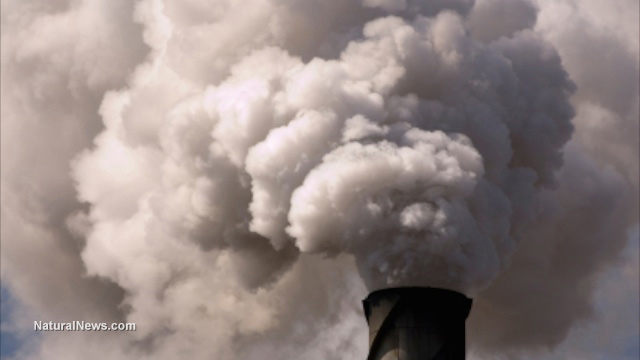Natural Weight Loss
Remove toxins from the body, restore digestive function, lose weig...
Natural Weight Loss
Remove toxins from the body, restore digestive function, lose weig...
China smog hits 50 times WHO limits, as U.S. consumers keep buying contaminated herbs and food from China

(NaturalNews) In China, the fog in Changchun, the capital of Jilin province in the northeast, is so thick that buildings in the area are completely invisible. In other areas throughout the country, it's not uncommon for people to walk the streets wearing face masks, surrounded by a blanket of haze. China's smog problem – brought on primarily by vehicular emissions, heating needs and rising industrialism – has long been an issue. However, it's recently reached a high of epic proportions.(1)
So bad is the smog that it's now reached a shocking 50 times the World Health Organization's (WHO) maximum. The organization recommends a maximum of 25 micrograms of the dangerous smog particulates during a 24-hour period. But in Shenyang, China, that figure has been exceeded to an unbelievable degree, reaching a whopping 1400 micrograms – more than 50 times what WHO suggests. In this area, it's coal use that's mostly to blame, with many people pointing fingers at heating companies who opt to use cheap, low-quality coal that wreaks havoc on the environment and in turn, on human health.(1)
"Inhalable particles" lead to health issues such as lung cancer and heart disease
Indeed, more than the issue of diminished visibility are the serious health problems linked to living in a smog-filled environment. According to an Environmental Health Perspectives abstract, China's increasing number of "inhalable particles" has greatly contributed to a rise in hospitalizations, premature mortality and respiratory problems. Lung cancers, emphysema, stroke and heart disease are also common. Air pollution there is also linked to serious water quality issues; exposure to it has been linked to digestive cancers as well as hepatitis and cholera.(1,2)
It's these health concerns that leads people to walk around the streets wearing disposable face masks, or – like one person seen biking through Shenyang – gas masks. At the very least, most people cover their noses and mouths with their hands, or lift the necks of their shirts for the same purpose. Unfortunately, these efforts do little to make a dent in improving health and the overall way of life in China; Shenyang's respiratory ward, for example, has reached capacity. It's also not unusual for people countrywide to frequently receive emergency warnings urging them to stay indoors.(1)
In fact, a few years ago, dangerous levels of smog almost entirely shut down Harbin, the capital of northeastern Heilongjiang province. There, 11 million people were affected, as dangerous particulate levels – associated with the first day of heating being turned on for the colder winter season – led to the suspension of school classes and the closing of the airport and several bus routes.(3)
So, with China's huge smog problem, why would you eat their contaminated food?
Efforts to address the problem include everything from supporting public transportation to rooftop gardens. Using public transportation more often will cut down on vehicular pollution; in some instances, there are bans on individual car use on days when air pollution is deemed particularly high. As for rooftop gardens, it's thought that the greenery will help contribute to a cleaner environment. Furthermore, it's believed that talking more about health problems associated with poor air quality will also serve as a wake-up call that will encourage more action.(4)
"Crucially, re-framing climate change as a human health issue makes it a much more tangible concept," says Nick Watts, director of the Global Climate and Health Alliance. Watts explains that couching much of this issue in terms of one's health makes the issue more relatable. Discussing such things as atmospheric concentration of carbon dioxide, he says, are often too complex and therefore, not enough to get people to take action.
The air quality in China is all the more reason not to consume herbs and other foods from that country. If it's getting into people's bodies over there, filling their respiratory wards to the brim, and causing the declaration of massive emergencies, it's certainly contaminating the food supply.
As always, choose fresh, organic foods that are locally-grown. Of course, it doesn't get any more locally-grown than your own home, so why not consider growing indoor herbs in window containers or, even better, turning to FoodRising.org. The site is filled with self-sustainability ideas from Mike Adams, including his Mini-Farm Grow Boxes which allow you to easily grow fruits and vegetables yourself.
Sources for this article include:
(1) News.Yahoo.com
(2) NCBI.nlm.nih.gov
(3) Reuters.com
(4) WHO.Int
Learn more: http://www.naturalnews.com/052030_smog_China_contaminated_food.html#ixzz3s4QeeXGi
This Forum message belongs to a larger discussion thread. See the complete thread below. You can reply to this message!
-
China smog hits 50 times WHO limits, as U.S. consu...
 InCharge
9 y
182
InCharge
9 y
182
This is the position of the above message within the thread.
CureZone Newsletter is distributed in partnership with https://www.netatlantic.com
Contact Us - Advertise - Stats
0.119 sec, (5)

